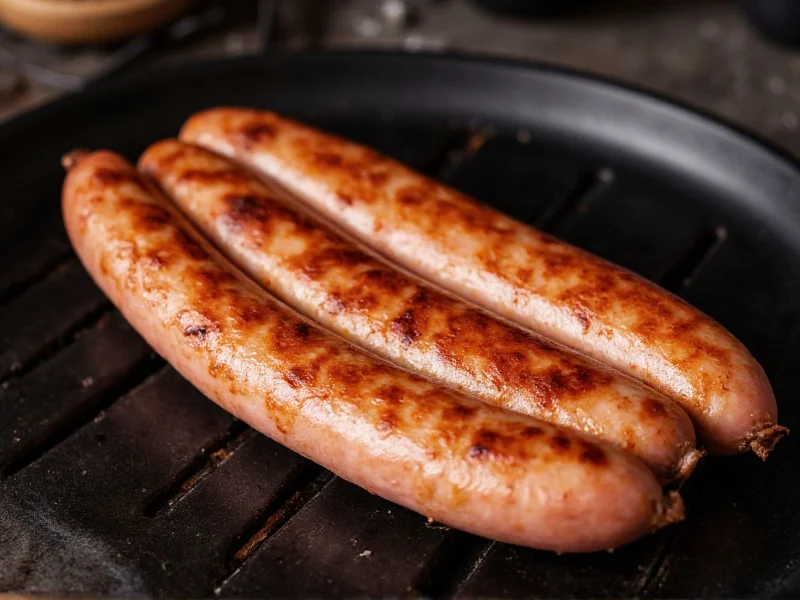Getting the sausage cook temp right isn't just about taste—it's critical for food safety. Undercooked sausage can harbor harmful bacteria like Salmonella and E. coli, while overcooked sausage becomes dry and unappetizing. This guide provides science-backed temperature recommendations to help you cook sausage perfectly every time.
Why Temperature Matters More Than Cooking Time
Cooking times vary significantly based on sausage size, cooking method, and starting temperature. Relying solely on time can lead to unsafe undercooking or disappointing results. The USDA Food Safety and Inspection Service emphasizes that internal temperature is the only reliable indicator of doneness.
Meat enters the "danger zone" between 40°F and 140°F, where bacteria multiply rapidly. Cooking sausage to the proper internal temperature destroys harmful pathogens while preserving moisture and flavor.
Essential Tools for Accurate Temperature Reading
Using an instant-read digital thermometer is crucial for checking sausage cook temp accurately. Here's how to use it properly:
- Insert the probe into the thickest part of the sausage
- Avoid touching the cooking surface or bone
- Check multiple sausages in a batch
- Wait 10-15 seconds for an accurate reading
- Clean the thermometer between readings
Complete Sausage Temperature Guide by Type
| Sausage Type | Safe Internal Temperature | Visual Doneness Indicators |
|---|---|---|
| Pork sausages (bratwurst, Italian, breakfast) | 160°F (71°C) | No pink color, clear juices |
| Beef sausages | 160°F (71°C) | Brown throughout, firm texture |
| Chicken or turkey sausages | 165°F (74°C) | No pink, juices run clear |
| Pre-cooked sausages (to heat) | 140°F (60°C) | Steaming hot throughout |
Optimal Cooking Methods and Temperature Tips
Stovetop Cooking
For perfect stovetop sausage cook temp results:
- Start with medium heat to render fat gradually
- Turn frequently for even cooking
- Finish at lower heat to reach target temperature without burning
- Allow 3-5 minutes resting time after cooking (temperature rises 5-10°F)
Grilling Sausages
When grilling, use a two-zone fire:
- Start over indirect heat until internal temperature reaches 140°F
- Finish over direct heat for caramelization
- Never pierce sausages while cooking (causes juice loss)
- Check temperature away from grill grates
Oven Baking
For consistent oven results:
- Bake at 350-375°F until reaching target sausage cook temp
- Use a wire rack for even air circulation
- Rotate the pan halfway through cooking
- Verify temperature in multiple spots
Food Safety Considerations for Sausage Preparation
Proper handling before and after cooking affects your sausage cook temp success:
- Keep raw sausage refrigerated below 40°F until ready to cook
- Never thaw sausage at room temperature
- Use separate cutting boards for raw meat
- Wash hands thoroughly after handling raw sausage
- Consume cooked sausage within 2 hours or refrigerate promptly
- Store leftovers at 40°F or below for up to 3-4 days
Common Sausage Cooking Mistakes to Avoid
Mistake: Judging doneness by color alone
Solution: Always verify with a thermometer—some sausages retain pink color even when properly cooked due to curing agents.
Mistake: Slicing to check doneness
Solution: This releases precious juices—use a thermometer instead for accurate sausage cook temp reading without damage.
Mistake: Ignoring carryover cooking
Solution: Remove sausages from heat when 5-10°F below target temperature, as residual heat will continue cooking them.
Special Considerations for Different Sausage Styles
Fresh sausages: Require full cooking to recommended temperatures. Never serve rare or medium-rare.
Cured sausages (like salami): Are safe to eat without cooking, but heating enhances flavor. If heating, bring to 140°F.
Smoked sausages: May be pre-cooked—check packaging. If so, heat to 140°F. If raw, cook to standard temperatures.
Vegetarian sausages: Don't require specific temperatures for safety, but should reach 165°F for optimal texture and to eliminate any potential contaminants.
Frequently Asked Questions
Can I tell if sausage is cooked by color alone?
No, color alone is unreliable for determining sausage doneness. Some sausages retain pink color due to curing agents even when properly cooked. Always use a meat thermometer to verify the internal temperature has reached 160°F for pork/beef or 165°F for poultry sausages.
What happens if I eat sausage cooked below 160°F?
Consuming sausage cooked below the recommended temperature (160°F for pork/beef, 165°F for poultry) increases your risk of foodborne illness. Undercooked sausage may contain harmful bacteria like Salmonella, E. coli, or Listeria that are only destroyed at proper temperatures.
Does sausage temperature continue rising after removing from heat?
Yes, sausage experiences carryover cooking after being removed from heat. The internal temperature typically rises 5-10°F during resting. To prevent overcooking, remove sausages from heat when they reach 150-155°F for pork/beef or 155-160°F for poultry, then let them rest for 3-5 minutes.
How long should I rest sausage after cooking?
Rest sausage for 3-5 minutes after cooking. This allows the internal temperature to stabilize, juices to redistribute, and carryover cooking to complete. Resting ensures your sausage maintains the proper cooked temperature while becoming more tender and flavorful.
Can I use the same thermometer for raw and cooked sausage?
Yes, but you must clean and sanitize the thermometer probe between uses with raw and cooked sausage. Bacteria from raw meat can contaminate cooked food. Wipe the probe with an alcohol swab or wash thoroughly with hot, soapy water before reinserting into cooked sausage to check final temperature.











 浙公网安备
33010002000092号
浙公网安备
33010002000092号 浙B2-20120091-4
浙B2-20120091-4